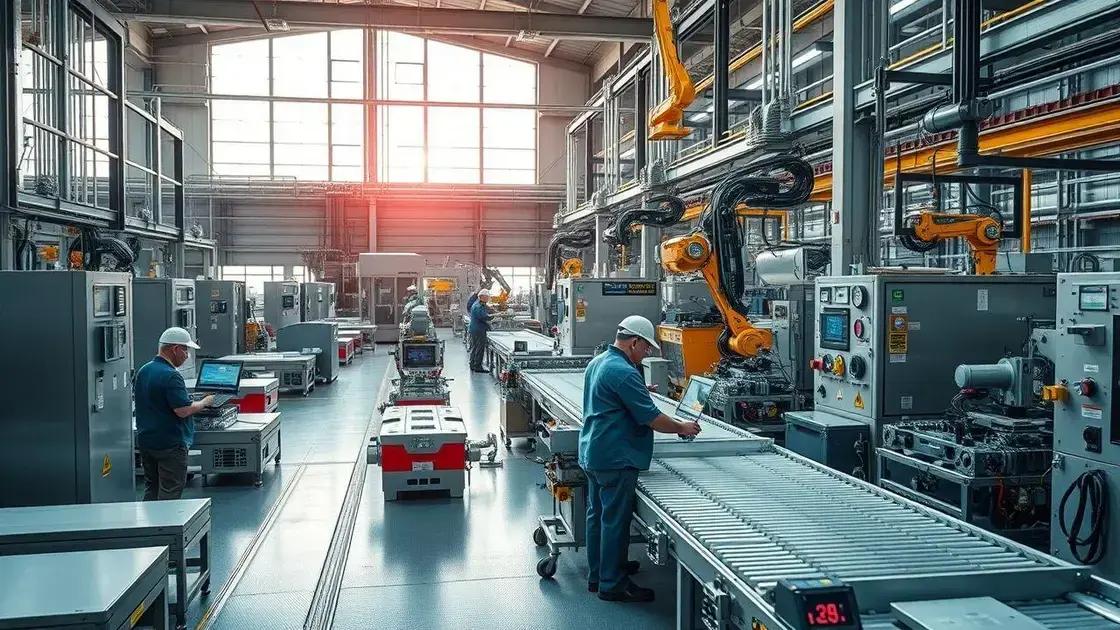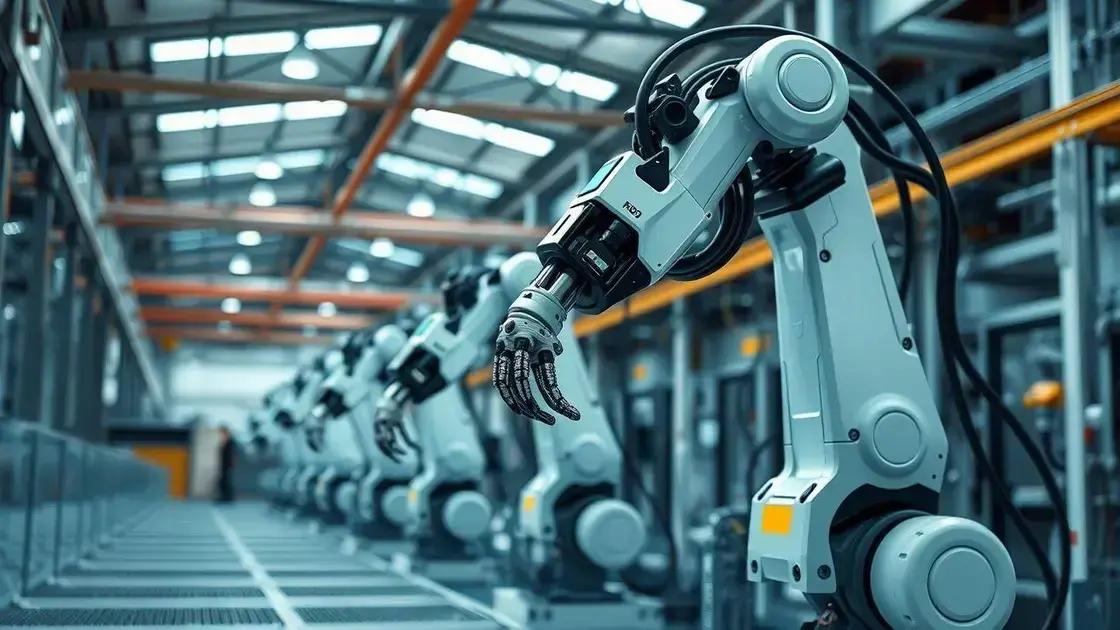Biden’s initiative to revitalize American manufacturing

Anúncios
Biden’s initiative to revitalize American manufacturing focuses on enhancing job creation, promoting technological advancements, and encouraging sustainable practices to bolster the economy and strengthen the manufacturing sector.
Biden’s initiative to revitalize American manufacturing is creating waves across various industries. But what does this mean for workers and businesses? Let’s explore the changes ahead.
Anúncios
Understanding Biden’s manufacturing plan
Understanding Biden’s manufacturing plan is essential to grasp how it aims to reshape the American economy. This initiative focuses on rejuvenating manufacturing processes and increasing competitiveness.
Key Goals of the Plan
The plan intends to address several core issues affecting the manufacturing sector today. By investing in infrastructure and technology, the administration hopes to create jobs and modernize facilities.
Anúncios
- Boosting job creation across various sectors
- Encouraging green manufacturing practices
- Enhancing supply chain resilience
- Fostering innovation in production technology
Additionally, the initiative emphasizes the importance of local economies. It aims to support smaller businesses and ensure communities thrive through strengthened manufacturing capabilities.
Impact on Workers and Communities
The initiative promises to transform the lives of many workers by providing training and upskilling opportunities. Workers will receive support to adapt to new technologies, making them more valuable in the evolving job market. This empowers individuals and helps communities grow.
Biden’s plan is not only about immediate job creation but also about future-proofing the manufacturing industry. By focusing on eco-friendly practices, the administration is setting a foundation for sustainable growth. This is critical as industries worldwide shift toward environmentally responsible methods.
As the plan rolls out, it will likely create numerous opportunities for innovation and entrepreneurship. Businesses that align with the initiative’s goals can benefit from government support and funding. Ensuring a competitive edge in a global market will be easier as newer technologies are adopted and integrated.
Key components of the initiative
Key components of the initiative are pivotal in understanding how Biden plans to reshape American manufacturing. This comprehensive strategy focuses on revitalizing industries while embracing innovation and sustainability.
Investment in Infrastructure
A major pillar of the initiative is substantial investment in infrastructure. The aim is to upgrade roads and transportation systems that support manufacturing, making it easier and more efficient for businesses to operate. These upgrades are essential for enhancing supply chain management and reducing delays.
- Improving transportation networks
- Modernizing energy supplies
- Expanding broadband access for businesses
Next, the initiative emphasizes the importance of advanced manufacturing technologies. This includes promoting automation, artificial intelligence, and robotics to enhance productivity. By integrating cutting-edge technologies, manufacturers can streamline their operations and reduce costs.
Focus on Green Manufacturing
Another significant aspect is the push for eco-friendly practices. The plan encourages companies to adopt sustainable methods in production. This not only aligns with global trends towards sustainability but also opens up new markets and opportunities for growth.
The initiative also prioritizes workforce development. Training programs will ensure that workers can gain the necessary skills to excel in a modern manufacturing environment. This commitment to education and training is crucial for maintaining a competitive workforce.
As we delve deeper, it’s clear that these components are interconnected. Investments in infrastructure and technology create a foundation for job growth. Meanwhile, a focus on sustainable practices ensures that the industry evolves responsibly.
Impacts on job creation and economy

The impacts on job creation and the economy from Biden’s initiative are profound and far-reaching. This program aims to generate new jobs while rejuvenating the American economy through strategic investments.
Job Creation Initiatives
A key aspect of the plan is its emphasis on job creation. The initiative is expected to create thousands of jobs in various sectors, particularly in manufacturing and technology. By targeting specific industries, the plan aims to ensure that these new jobs are sustainable and provide long-term benefits.
- Investment in green technologies
- Enhancement of local manufacturing
- Support for small businesses
Furthermore, many of these jobs will focus on high-skill opportunities, helping workers adapt to emerging technologies. Training and upskilling programs are an essential component, ensuring that workers have the skills needed to thrive in modern environments.
Economic Growth Potential
The impact on the economy extends beyond job creation. The initiative aims to boost the overall economic growth by promoting manufacturing domestically. With more goods being produced in the U.S., consumers can expect higher-quality products and a more stable supply chain.
Moreover, a stronger manufacturing base can lead to increased investments in related sectors. Supply chains will become more efficient, further reducing costs for consumers and businesses alike. This interconnectedness is crucial for fostering a robust economy.
As manufacturing and technology sectors grow, communities will benefit as well. By revitalizing local economies, the initiative supports social infrastructure through improved services and local business growth. Furthermore, a thriving economy positively impacts education and healthcare systems.
Challenges and criticisms
The challenges and criticisms surrounding Biden’s initiative highlight various concerns about its implementation and long-term effectiveness. While many welcome the plan, critics point out several obstacles that could hinder its success.
Concerns Over Funding
One major challenge is securing adequate funding for the initiative. With competing national priorities, budget constraints can limit the resources allocated to manufacturing programs. This raises concerns about whether the goals can be achieved without sufficient financial support.
- Potential for reduced funding over time
- Impact on ambitious projects requiring investment
- Reliance on ongoing political support
Additionally, some groups argue that the initiative may favor larger corporations over small businesses. Small manufacturers may struggle to compete for grants or resources, causing a growing disparity within the manufacturing sector.
Implementation Obstacles
Implementation obstacles also loom large. Transitioning to new manufacturing processes can be complicated and time-consuming. Companies may face challenges in adopting new technologies effectively, especially if they lack the workforce skills necessary for these advancements.
Moreover, **supply chain disruptions** may affect the initiative’s goals. Issues like shipping delays and material shortages can prevent manufacturers from scaling up production as intended. This unpredictability may undermine the initiative’s overall objectives.
As the initiative unfolds, ongoing criticisms focus on whether it truly addresses the core issues of the manufacturing sector. Critics question if the strategies presented will yield substantial benefits or merely serve as temporary solutions.
Future outlook for American manufacturing
The future outlook for American manufacturing is exciting yet complex. As Biden’s initiative unfolds, the potential for growth and innovation presents a bright horizon for the industry. The key is to embrace technological advancements while addressing current challenges.
Embracing Technology
One significant change expected in the coming years is the increased use of automation and artificial intelligence. These technologies can streamline operations and improve efficiency. As companies invest in modern systems, they will likely see enhanced productivity and reduced costs.
- Integration of robotics in manufacturing processes
- Adoption of smart factories
- Utilization of data analytics for decision-making
Moreover, the continued focus on sustainability will shape the future of manufacturing. Companies are likely to adopt greener practices to meet consumer demands. This shift may involve using renewable energy sources and minimizing waste in production processes.
Workforce Development
Workforce development is another crucial aspect of the future outlook. As technologies evolve, there will be a growing need for skilled workers. Educational programs focusing on STEM skills will be essential in preparing the future workforce for these roles.
Collaboration between educational institutions and manufacturing companies can foster an environment where skills match market needs. This connection can help students acquire practical experience while contributing to the manufacturing sector.
As these elements come together, American manufacturing can become more competitive on a global scale. With a strong focus on innovation and sustainability, the industry is poised for a transformative era. However, ongoing efforts to address potential challenges will be needed to ensure long-term success.
FAQ – Frequently Asked Questions about Biden’s Initiative to Revitalize American Manufacturing
What are the main goals of Biden’s manufacturing initiative?
The main goals include boosting job creation, supporting local economies, and transitioning to sustainable manufacturing practices.
How will technology impact American manufacturing in the future?
Technology will enhance efficiency through automation and AI, optimizing production processes and reducing costs.
What challenges does the initiative face?
Challenges include securing adequate funding, addressing workforce development, and ensuring small businesses have equal access to resources.
Why is workforce training important for the manufacturing sector?
Training ensures that workers are equipped with the necessary skills to adapt to new technologies and meet industry demands.






